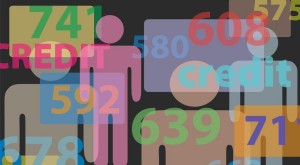Quali sono le gamme FICO Score®?
Quando stai tentando di migliorare il tuo punteggio di credito, è importante sapere come gli istituti di credito classificano i punteggi di credito. In questo modo, puoi determinare dove dovrebbe essere il tuo per raggiungere i tuoi obiettivi finanziari.

È fantastico aumentare il tuo punteggio di 100 punti, ma se sei ancora nella categoria "cattivo", non avrai comunque molta fortuna nell'ottenere l'approvazione per un prestito, una carta di credito o un mutuo.
Intervallo punteggio FICO®:300 – 850
Quindi, come vengono classificati i punteggi FICO? Le categorie possono variare in base al prestatore, ma i punteggi in genere sono i seguenti:
Credito eccellente:800 – 850
È molto probabile che tu venga approvato per un prestito o una carta di credito, inoltre riceverai l'accesso ai migliori tassi di interesse e condizioni. Il punteggio di credito più alto che puoi avere è 850.
Credito molto buono:740 – 799
Riceverai comunque alcune delle migliori tariffe quando richiedi il credito. In effetti, alcuni istituti di credito considerano 720 la soglia per i tassi di interesse più bassi, quindi potrebbe non essere nemmeno importante se il tuo punteggio è superiore a quello.
Buon credito:670 – 739
Il punteggio di credito medio dell'americano è 695, che rientra nella categoria "buono". Probabilmente non hai molti elementi negativi importanti elencati nel tuo rapporto di credito, ma c'è spazio per miglioramenti per assicurarti di ottenere i migliori termini di finanziamento.
Credito equo:580 – 669
Le tue tariffe in questa categoria non saranno sicuramente le migliori disponibili, il che potrebbe finire per costarti migliaia di dollari, se non di più, la prossima volta che prenderai un prestito o porterai un saldo sulla tua carta di credito.
Credito scarso:300 – 579
Hai sicuramente alcuni elementi negativi e potresti avere difficoltà a ottenere l'approvazione per il credito, che si tratti di una nuova carta o di un prestito. Se ottieni l'approvazione, le tue tariffe saranno estremamente alte.
La buona notizia è che c'è molto spazio per migliorare nella categoria. La cattiva notizia è che probabilmente avrai bisogno di quel miglioramento per ottenere l'approvazione per un prestito. Ad esempio, il punteggio minimo per un mutuo per la casa FHA è 580, quindi se sicuramente non sarai idoneo se il tuo credito è in questa categoria.
Grafico dei punteggi FICO®
Probabilmente sai dove rientri in queste categorie di credito, ma che ne dici di tutti gli altri nel paese? Con il 54,7%, poco più della metà della popolazione ha un punteggio di 700 o superiore.
Circa il 23% delle persone ha un punteggio compreso tra 600 e 699 e il 22% ha un punteggio inferiore a 600. Ciò significa che quasi un quarto degli americani ha scarso credito o è sul punto di scendere al di sotto della soglia di 579.
| Molto mediocre | scarso | Media | Buono | Molto buono | Eccellente |
| 579 | 619 | 679 | 719 | 779 | 850 |
| 578 | 618 | 678 | 718 | 778 | 849 |
| 577 | 617 | 677 | 717 | 777 | 848 |
| 576 | 616 | 676 | 716 | 776 | 847 |
| 575 | 615 | 675 | 715 | 775 | 846 |
| 574 | 614 | 674 | 714 | 774 | 847 |
| 573 | 613 | 673 | 713 | 773 | 846 |
| 572 | 612 | 672 | 712 | 772 | 845 |
| 571 | 611 | 671 | 711 | 771 | 844 |
| 570 | 610 | 670 | 710 | 770 | 843 |
| 569 | 609 | 669 | 709 | 769 | 842 |
| 568 | 608 | 668 | 708 | 768 | 841 |
| 567 | 607 | 667 | 707 | 767 | 840 |
| 566 | 606 | 666 | 706 | 766 | 839 |
| 565 | 605 | 665 | 705 | 765 | 838 |
| 564 | 604 | 664 | 704 | 764 | 837 |
| 563 | 603 | 663 | 703 | 763 | 836 |
| 562 | 602 | 662 | 702 | 762 | 835 |
| 561 | 601 | 661 | 701 | 761 | 834 |
| 560 | 600 | 660 | 700 | 760 | 833 |
| 559 | 599 | 659 | 699 | 759 | 832 |
| 558 | 598 | 658 | 698 | 758 | 831 |
| 557 | 597 | 657 | 697 | 757 | 830 |
| 556 | 596 | 656 | 696 | 756 | 829 |
| 555 | 595 | 655 | 695 | 755 | 828 |
| 554 | 594 | 654 | 694 | 754 | 827 |
| 553 | 593 | 653 | 693 | 753 | 826 |
| 552 | 592 | 652 | 692 | 752 | 825 |
| 551 | 591 | 651 | 691 | 751 | 824 |
| 550 | 590 | 650 | 690 | 750 | 823 |
| 549 | 589 | 649 | 689 | 749 | 822 |
| 548 | 588 | 648 | 688 | 748 | 821 |
| 547 | 587 | 647 | 687 | 747 | 820 |
| 546 | 586 | 646 | 686 | 746 | 819 |
| 545 | 585 | 645 | 685 | 745 | 818 |
| 544 | 584 | 644 | 684 | 744 | 817 |
| 541 | 583 | 643 | 683 | 743 | 816 |
| 540 | 582 | 642 | 682 | 742 | 815 |
| 539 | 581 | 641 | 681 | 741 | 814 |
| 538 | 580 | 640 | 680 | 740 | 813 |
| 537 | 639 | 739 | 812 | ||
| 536 | 638 | 738 | 811 | ||
| 535 | 637 | 737 | 810 | ||
| 534 | 636 | 736 | 809 | ||
| 533 | 635 | 735 | 808 | ||
| 532 | 634 | 734 | 807 | ||
| 531 | 633 | 733 | 806 | ||
| 530 | 632 | 732 | 805 | ||
| 529 | 631 | 731 | 804 | ||
| 528 | 630 | 730 | 803 | ||
| 527 | 629 | 729 | 802 | ||
| 526 | 628 | 728 | 801 | ||
| 525 | 627 | 727 | 800 | ||
| 524 | 626 | 726 | 799 | ||
| 523 | 625 | 725 | 798 | ||
| 522 | 624 | 724 | 797 | ||
| 521 | 623 | 723 | 796 | ||
| 520 | 622 | 722 | 795 | ||
| 519 | 621 | 721 | 794 | ||
| 518 | 620 | 720 | 793 | ||
| 517 | 792 | ||||
| 516 | 791 | ||||
| 515 | 790 | ||||
| 514 | 789 | ||||
| 513 | 788 | ||||
| 512 | 787 | ||||
| 511 | 786 | ||||
| 510 | 785 | ||||
| 509 | 784 | ||||
| 508 | 783 | ||||
| 507 | 782 | ||||
| 506 | 781 | ||||
| 505 | 780 | ||||
| 504 | |||||
| 503 | |||||
| 502 | |||||
| 501 | |||||
| 500 | |||||
| 499 | |||||
| 498 | |||||
| 497 | |||||
| 496 | |||||
| 495 | |||||
| 494 | |||||
| 493 | |||||
| 492 | |||||
| 491 | |||||
| 490 | |||||
| 489 | |||||
| 488 | |||||
| 487 | |||||
| 486 | |||||
| 485 | |||||
| 484 | |||||
| 483 | |||||
| 482 | |||||
| 481 | |||||
| 480 | |||||
| 479 | |||||
| 478 | |||||
| 477 | |||||
| 476 | |||||
| 475 | |||||
| 474 | |||||
| 473 | |||||
| 472 | |||||
| 471 | |||||
| 470 | |||||
| 469 | |||||
| 468 | |||||
| 467 | |||||
| 466 | |||||
| 465 | |||||
| 464 | |||||
| 463 | |||||
| 462 | |||||
| 461 | |||||
| 460 | |||||
| 459 | |||||
| 458 | |||||
| 457 | |||||
| 456 | |||||
| 455 | |||||
| 454 | |||||
| 453 | |||||
| 452 | |||||
| 451 | |||||
| 450 | |||||
| 449 | |||||
| 448 | |||||
| 447 | |||||
| 446 | |||||
| 445 | |||||
| 444 | |||||
| 443 | |||||
| 442 | |||||
| 441 | |||||
| 440 | |||||
| 439 | |||||
| 438 | |||||
| 437 | |||||
| 436 | |||||
| 435 | |||||
| 434 | |||||
| 433 | |||||
| 432 | |||||
| 431 | |||||
| 430 | |||||
| 429 | |||||
| 428 | |||||
| 427 | |||||
| 426 | |||||
| 425 | |||||
| 424 | |||||
| 423 | |||||
| 422 | |||||
| 421 | |||||
| 420 | |||||
| 419 | |||||
| 418 | |||||
| 417 | |||||
| 416 | |||||
| 415 | |||||
| 414 | |||||
| 413 | |||||
| 412 | |||||
| 411 | |||||
| 410 | |||||
| 409 | |||||
| 408 | |||||
| 407 | |||||
| 406 | |||||
| 405 | |||||
| 404 | |||||
| 403 | |||||
| 402 | |||||
| 401 | |||||
| 400 | |||||
| 399 | |||||
| 398 | |||||
| 397 | |||||
| 396 | |||||
| 395 | |||||
| 394 | |||||
| 393 | |||||
| 392 | |||||
| 391 | |||||
| 390 | |||||
| 389 | |||||
| 388 | |||||
| 387 | |||||
| 386 | |||||
| 385 | |||||
| 384 | |||||
| 383 | |||||
| 382 | |||||
| 381 | |||||
| 380 | |||||
| 379 | |||||
| 378 | |||||
| 377 | |||||
| 376 | |||||
| 375 | |||||
| 374 | |||||
| 373 | |||||
| 372 | |||||
| 371 | |||||
| 370 | |||||
| 369 | |||||
| 368 | |||||
| 367 | |||||
| 366 | |||||
| 365 | |||||
| 364 | |||||
| 363 | |||||
| 362 | |||||
| 361 | |||||
| 360 | |||||
| 359 | |||||
| 358 | |||||
| 357 | |||||
| 356 | |||||
| 355 | |||||
| 354 | |||||
| 353 | |||||
| 352 | |||||
| 351 | |||||
| 350 | |||||
| 349 | |||||
| 348 | |||||
| 347 | |||||
| 346 | |||||
| 345 | |||||
| 344 | |||||
| 343 | |||||
| 342 | |||||
| 341 | |||||
| 340 | |||||
| 339 | |||||
| 338 | |||||
| 337 | |||||
| 336 | |||||
| 335 | |||||
| 334 | |||||
| 333 | |||||
| 332 | |||||
| 331 | |||||
| 330 | |||||
| 329 | |||||
| 328 | |||||
| 327 | |||||
| 326 | |||||
| 325 | |||||
| 324 | |||||
| 323 | |||||
| 322 | |||||
| 321 | |||||
| 320 | |||||
| 319 | |||||
| 318 | |||||
| 317 | |||||
| 316 | |||||
| 315 | |||||
| 314 | |||||
| 313 | |||||
| 312 | |||||
| 311 | |||||
| 310 | |||||
| 309 | |||||
| 308 | |||||
| 307 | |||||
| 306 | |||||
| 305 | |||||
| 304 | |||||
| 303 | |||||
| 302 | |||||
| 301 | |||||
| 300 |
Why Good Credit Matters
It’s important to have a good credit score as high as possible because the higher your interest rate, the more money you’ll pay over time. That can really add up for high-value loans like cars or mortgages.
Let’s look at a quick example. If you have excellent credit and take out a mortgage for $100,000 over 30 years and your rate is a low 3.92%, you’ll end up paying an additional $70,000 in interest payments.
If you think that’s a lot of money, wait until you see the next set of numbers. Bump that rate up to 5.92% for someone with a lower credit score, and they’ll end up paying over $113,000 in interest. That’s more than the loan itself! And it’s $43,000 more than the first person paid with a better interest rate.
The High Cost of Bad Credit
Even if you’re not planning on buying a home anytime soon, the same principles apply to credit cards, car loans, student loans, and other loans. The lower your credit score, the more money you’ll have to pay. Plus, landlords and even some employers now do credit checks as part of their application processes.
With a bad credit score, you might have difficulty finding a home or even a job. And if you have a financial emergency, you might be stuck with high-fee options like payday loans or title loans, which can add up fast and even cost you your car.
If you fall into one of the lower credit rankings, it’s time to start evaluating your credit reports. That way you can find out how you can improve that score and keep your financial opportunities wide open.
Industry Specific Credit Scores
Now that you know what a good credit score is, it’s time to get more specific.
Traditional FICO scores from the popular scoring company Fair Isaac Corporation range from 300 to 850. However, there are actually several credit scoring models that lenders might use when judging your creditworthiness. These vary depending on what type of credit you’re applying for.
A few examples include versions specifically for mortgages, car loans, credit cards, and student loans. Each one will look at slightly different information that is more relevant to the exact type of credit you want.
Your Credit Scores Are Different Depending on What You Apply For
The model for credit cards more heavily weighs your revolving payment history, while the auto-version is going to pay more attention to your past car payments.
There are a couple of tricky parts that come with these alternative scoring models. The first is that you probably won’t know which credit scoring model your lender is going to use unless you ask.
Additionally, the credit score ranges are different from the traditional FICO model. Instead of ranging between 300 and 850, the industry-specific scores range between 250 and 900.
On the auto credit range, for example, you’ll want at least a 750 to get the best interest rates. So, you can see how the numbers vary slightly for each different model.
FICO vs. VantageScore
While FICO scores are the most popular ones used by lenders today, there are other companies competing in this space. The other major model is called VantageScore, which was actually created by the three credit bureaus.
VantageScore 2.0, which is still used by some lenders, calculates credit anywhere between 501 and 990.
The latest version, VantageScore 3.0, uses the same range as FICO to reduce confusion, 300–850. Just like FICO, the higher score you have on both types of VantageScore models, the better a lender views your credit.
What Else Do Lenders Look at Besides Credit Score?
Clearly, your credit score is a massive component of any financial application process. If you don’t meet certain minimums, there’s no way you’ll get approved or access the very best rates. That being said, lenders look at a lot of additional information beyond your credit score and credit report.
They also analyze your income level to make sure you can afford the loan amount you’ve requested. Even if you earn six figures, if you have too much debt or the loan amount is too high, the lender might question your ability to make your payment each month.
Employment History
They also look at your employment history. No matter how great your credit is, or how much money you make, most lenders want to see that you’ve been in the same job (or at least the same industry) for the past two years. They even check your tax statements and pay stubs to confirm your earnings and often require proof of employment.
A lender might also want to know how much in cash reserves you have on hand. They’ll likely want to see bank statements because the more savings you have, the more cushion you have to repay the loan even if you have a financial emergency, like medical bills or a lost job.
How to Get the Best Credit Score
Start by consistently paying all of your bills on time and in full. This is the best thing you can do for your credit score because it accounts for 35%—the biggest factor considered!
You should also order a free copy of your credit report to get an idea of what exactly is bogging down your score. Is there anything on there that’s incorrect or out of date? You might be able to dispute it and have it removed.
In the event you have multiple negative items, you could greatly benefit from talking to a credit repair company to help you clean up your credit history.
Get a Free Credit Consultation
Most companies, like Lexington Law Firm, offer a free consultation so you can ask questions about your specific situation and find out exactly what they can help you with.
Knowledge is power, and finding out your credit score and learning what range you fall in can help you plan the next steps in your financial future.
Never assume the worst-case scenario; there’s no such thing as a lost cause. Everyone, no matter how bad their credit score is, has the potential to improve their financial situation.
It might take a little time and effort, but it’s always doable. Professional credit repair companies that have been in the business for a long time have truly seen it all. Don’t be afraid to give one a call today and find out what you can do to increase your credit score.
Pronto ad aumentare il tuo punteggio di credito?
Chiama per una consulenza gratuita sul credito!
bancario
- Che cosa sono R1 e I1 nel rapporto di credito?
- Quali sono le dimensioni di una carta di credito?
- Quali sono gli elementi di credito?
- Quali sono i vantaggi del prestito di denaro?
- Quali sono le somiglianze tra banche e cooperative di credito?
- Qual è il punteggio di credito minimo per acquistare una casa?
- Cos'è un punteggio a crediti?
- Cosa sono i drag e i pull sulla liquidità?
- Qual è il punteggio di credito più alto?
- Quali sono i diversi tipi di debito?
-
 Qual è il punteggio di credito più alto che puoi ottenere?
Qual è il punteggio di credito più alto che puoi ottenere? Lintervallo di credito standard per i modelli di credit scoring più popolari, FICO e VantageScore, è 300-850. Questa gamma ha portato molte persone a credere di aver bisogno di un credito perfetto per...
-
 Che cos'è un punteggio FICO?
Che cos'è un punteggio FICO? Se hai mai tentato di ottenere un prestito o richiesto una carta di credito, probabilmente hai sentito il termine punteggio FICO menzionato in più di unoccasione. Tuttavia, se stai solo stabilendo i...


